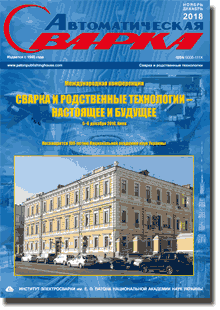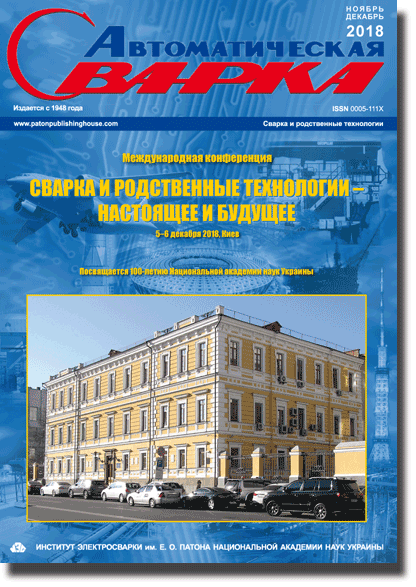| 2018 №12 (09) |
DOI of Article 10.15407/as2018.12.10 |
2018 №12 (11) |

«Автоматичне зварювання», № 11-12, 2018, с. 103-117
Анодні процеси у зварювальних дугах
І. В. Крівцун
ІЕЗ ім. Є. О. Патона НАН України. 03150, м. Київ, вул. Казимира Малевича, 11. E-mail: office@paton.kiev.ua
Описано підходи до теоретичного дослідження та математичні моделі фізичних процесів, що протікають в анодному шарі потужнострумових (~ 102 А) електричних дуг, що горять в інертному газі атмосферного тиску. Проведено чисельні дослідження анодних процесів в електричних дугах з анодом, який не випаровується (що охолоджується водою), а також у зварювальних дугах (дугах з анодом, який випаровується). Показано, що анодне падіння потенціалу в розглянутих дугах є негативним та має суттєво неоднорідний розподіл в зоні анодної прив’язки дуги. Остання обставина багато в чому визначає картину протікання електричного струму та переносу енергії між дуговою плазмою і анодом (контрагирування дуги на аноді або розподілений по поверхні анода розряд). З урахуванням зазначеної зміни анодного падіння потенціалу уздовж поверхні анода запропонована методика розрахунку ефективного анодного падіння в електричних дугах. Бібліогр. 32, табл. 1, рис. 15.
Ключові слова: зварювальна дуга, дугова плазма, стовп дуги, анодний шар, анодне падіння потенціалу, тепловий потік в анод, випаровування, математичне моделювання
Надійшла до редакції 10.09.2018
Підписано до друку 06.11.2018
Література
- Немчинский В. А., Перетц Л. Н. (1977) Прианодный слой сильноточной дуги высокого давления. ЖТФ, 47, 1868–1875.
- Dinulescu H. A., Pfender E. (1980) Analysis of the anode boundary layer of high intensity arcs. of Appl. Phys., 51, 3149–315.
- Дюжев Г. А., Немчинский В. А., Школьник С. М. и др. (1983) Анодные процессы в сильноточном дуговом разряде. Химия плазмы, 10, 169–209.
- Nazarenko I. P., Panevin I. G. (1989) Analysis of the near-anode processes character in argon arc discharge of high pressure. Plasma Phys., 29, 251–261.
- Nemchinsky V. A. (1994) Size and shape of the liquid droplet at the molten tip of an arc electrode. Phys. D: Appl. Phys., 27, 1433–1442.
- Jenista J., Heberlein J. V. R., Pfender E. (1997) Numerical model of the anode region of high-current electric arcs. IEEE Trans. on Plasma Science, 25, 883–890.
- Amakawa T., Jenista J., Heberlein J. et al. (1998) Anode-boundary-layer behavior in a transferred, high intensity arc. Phys. D: Appl. Phys., 31, 2826–2834.
- Tanaka M., Ushio M., Wu C. S. (1999) One-dimensional analysis of the anode boundary layer in free-burning argon arcs. Ibid, 32, 605–611.
- Murphy A. B.( 2010) The effects of metal vapour in arc welding. Ibid, 43, 434001 (31 pp).
- Zhu P., Lowke J. J., Morrow R. et al. (1995) Prediction of anode temperatures of free burning arcs. Ibid, 28, 1369–1376.
- Lowke J. J., Morrow R., Haidar J. (1997) A simplified unified theory of arcs and their electrodes. Ibid, 30, 2033–2042.
- Fan H. G., Kovacevic R. (2004) A unified model of transport phenomena in gas metal arc welding including electrode, arc plasma and molten pool. Ibid, 37, 2531–2544.
- Nishiyama H., Sawada T., Takana H. et al. (2006) Computational simulation of arc melting process with complex interactions. ISIJ International, 46, 705–711.
- J., Tsai H. L. (2007) Heat and mass transfer in gas metal arc welding. Part I: The arc. Int. J. of Heat and Mass Transfer, 50, 833–846.
- Masquere M., Freton P., Gonzalez J. J. (2007) Theoretical study in two dimensions of the energy transfer between an electric arc and an anode material. Phys. D: Appl. Phys., 40, 432–446.
- Benilov M. S. (2008) Understanding and modelling plasma-electrode interaction in high-pressure arc discharges: a review. Ibid, 41, 144001 (30 pp).
- Lancaster J. F. (1986) The physics of welding, 2nd Edition. Pergamon Press.
- Sanders N. A., Pfender E. (1984) Measurement of anode falls and anode heat transfer in atmospheric pressure high intensity arcs. of Appl. Phys., 55, 714–722.
- Tanaka M., Ushio M. (1999) Observations of the anode boundary layer in free-burning arcs. Phys. D: Appl. Phys., 32, 906–912.
- Krivtsun I., Demchenko V., Lesnoi A. et al. (2010) Modelling of electromagnetic processes in system «welding arc evaporating anode»: Part 1 Model of anode region. Science and Technology of Welding and Joining, 10, 457–462.
- Krivtsun I., Demchenko V., Krikent I. et al. (2015) Distributed and integrated characteristics of the near-anode plasma of the welding arc in TIG and Hybrid (TIG + CO2 Laser) welding. Mathematical Modelling of Weld Phenomena 11 Techn. Universität Graz, Graz, Austria, pp. 837–874.
- Semenov I. L., Krivtsun I. V., Reisgen U. (2016) Numerical study of the anode boundary layer in atmospheric pressure arc discharges. Phys. D: Appl. Phys., 49, 105204 (12 pp).
- Almeida N. A., Benilov M. S., Naidis G. V. (2008) Unified modelling of near-cathode plasma layers in high-pressure arc discharges. Ibid, 41, 245201 (26 pp).
- Zhdanov V. M. (2002) Transport processes in multicomponent plasma. London, Taylor&Francis.
- Krivtsun I. V. (2001) Model of evaporation of metal in arc, laser and laser-arc welding. The Paton Welding Journal, 3, 2–9.
- Бакшт Ф. Г., Дюжев Г. А., Митрофанов Н. К. и др. (1973) Зондовые измерения в низкотемпературной плотной плазме при высоких степенях ионизации. ЖТФ, 43, 12, 2574–2583.
- Чен Ф. (1967) Электрические зонды. Диагностика плазмы. Р. Хаддлстоун, С. Леонард (ред.). Москва, Мир, 94–164.
- Griem H. R. (1962) High-density correction in plasma spectroscopy. Rev., 128, 997–1001.
- Krivtsun I. V., Demchenko V. F., Krikent I. V. (2010) Model of the processes of heat, mass and charge transfer in the anode region and column of the welding arc with refractory cathode. The Paton Welding Journal, 6, 2–9.
- Krikent I. V., Krivtsun I. V., Demchenko V. F. (2014) Simulation of electric arc with refractory cathode and evaporating anode. Ibid, 9, 17–24.
- Demchenko V. F., Krivtsun I. V., Krikent I. V., et al. (2017) Force interaction of arc current with self magnetic field. Ibid, 3, 15–24.
- Semenov O., Demchenko V., Krivtsun I. et al. (2012) A dynamic model of droplet formation in GMA welding. Modelling and Simulation in Materials Science and Engineering, 20, 045003 (14 pp).
Вартість передплати/замовлення на журнали або окремі статті
| журнал/валюта | річний комплект друкований |
1 прим. друкований |
1 прим. електронний |
одна стаття (pdf) |
| AS/UAH | 1800 грн. | 300 грн. | 300 грн. | 150 грн. |
| AS/USD | 192 $ | 32 $ | 26 $ | 13 $ |
| AS/EUR | 180 € | 30 € | 25 € | 12 € |
| TPWJ/UAH | 7200 грн. | 600 грн. | 600 грн. | 280 грн. |
| TPWJ/USD | 384 $ | 32 $ | 26 $ | 13 $ |
| TPWJ/EUR | 348 € | 29 € | 24 € | 12 € |
| SEM/UAH | 1200 грн. | 300 грн. | 300 грн. | 150 грн. |
| SEM/USD | 128 $ | 32 $ | 26 $ | 13 $ |
| SEM/EUR | 120 € | 30 € | 25 € | 12 € |
| TDNK/UAH | 1200 грн. | 300 грн. | 300 грн. | 150 грн. |
| TDNK/USD | 128 $ | 32 $ | 26 $ | 13 $ |
| TDNK/EUR | 120 € | 30 € | 25 € | 12 € |
AS = «Автоматичне зварювання» - 6 накладів на рік;
TPWJ = «PATON WELDING JOURNAL» - 12 накладів на рік;
SEM = «Сучасна електрометалургія» - 4 наклада на рік;
TDNK = «Технічна діагностика та неруйнівний контроль» - 4 наклада на рік.





